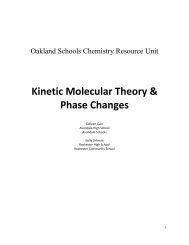Create successful ePaper yourself
Turn your PDF publications into a flip-book with our unique Google optimized e-Paper software.
Analysis and Conclusion Questions<br />
1. Can a molecule with nonpolar bonds ever be polar? Why or why not?<br />
2. Can a molecule with polar bonds ever be nonpolar? Why or why not?<br />
3. What is a dipole?<br />
4. List the five different molecular geometries we will encounter in this lab and<br />
indicate the bond angles for each.<br />
5. Does there appear to be a correlation between molecular geometry and polarity?<br />
Do you notice a pattern between symmetry of a molecule and polarity?<br />
6. Did the bond angles from the software differ from those you had predicted?<br />
(Look at BF 2 Cl, H 2 CO, and CH 3 Cl) Why might this occur?<br />
7. Looking at the last three molecules, does your data support the idea that triple<br />
bonds are shorter than double bonds, which are shorter than single bonds? Why<br />
or why not?<br />
8. Looking at the first two molecules, explain why N 2 has a shorter bond length<br />
than O 2 , even though oxygen has a smaller atomic radius.<br />
9. The polarity of a substance can have a great effect on its reactivity and<br />
solubility. A rough rule for solubility is “like dissolves like.” Knowing the general<br />
rule, what can you predict about the polarity of alcohol if you know that alcohol<br />
dissolves in water? Why do you think that dry cleaners do not use water or<br />
alcohol to dissolve greasy stains?
















